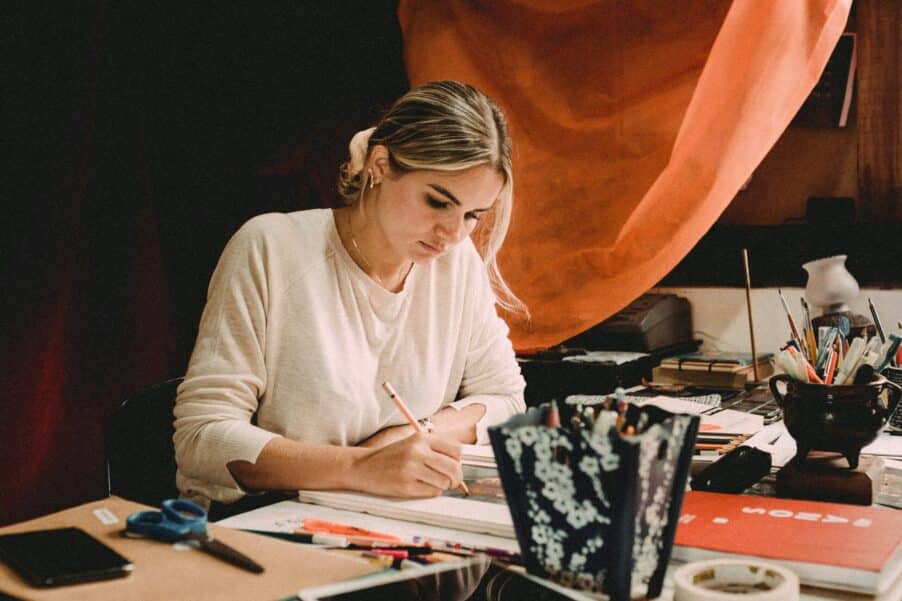Rejoignez-nous pour approfondir le rôle essentiel que joue la marque personnelle pour les créateurs, et découvrir comment les artistes peuvent s'épanouir dans leur identité unique, tout en communiquant habilement leur vision pour captiver leur public, établir de meilleures relations avec leurs clients et décrocher les contrats qu'ils souhaitent.
Cet article traite de la définition d'une marque personnelle et de la manière de maximiser les avantages de la sincérité, de la narration et de la définition de vos valeurs tout au long de votre présence en ligne et de vos interactions personnelles.
Les bases de l'image de marque personnelle
Vous avez peut-être lu beaucoup de choses sur l'image de marque personnelle. Ou peut-être est-ce tout nouveau pour vous. Quoi qu'il en soit, cet article vous servira d'étalon pour vous situer et vous suggérer des améliorations possibles à apporter à votre image de marque.
Votre marque, c'est ce qui fait que vous êtes, eh bien, vous ! Ne vous laissez pas submerger par ce que vous devez inclure, comme des prix ou des accolades. C'est une bonne chose, mais ce n'est pas ce que les clients potentiels (et existants) recherchent vraiment. Ce que les gens veulent, c'est mieux vous connaître, en tant qu'artiste créatif, et savoir comment votre personnalité, votre vision et vos valeurs influencent ce que vous faites.
Mais avant d'aborder tout cela, définissons d'abord ce qu'est exactement une marque personnelle.
Définir l'image de marque personnelle
Lorsque vous pensez à l'image de marque personnelle, vous pensez probablement à la cohérence d'un logo et à la manière dont il est lié à votre style de travail. Si un bon logo peut aider les gens à identifier votre marque, l'image de marque personnelle est bien plus que cela.
L'image de marque personnelle est le processus de définition et de promotion de ce que vous représentez en tant qu'individu, et dans le cas présent en tant que professionnel de la création. C'est l'aboutissement des expériences, des compétences et des valeurs qui vous différencient, comme une série d'empreintes créatives que vous laissez ici et là dans votre travail et votre style de communication.
Après avoir pris le temps de définir votre image de marque personnelle, celle-ci se reflétera non seulement dans les éléments suivants comment Ce n'est pas tant le contenu de vos créations que les sentiments évoqués par votre public grâce à votre style créatif, et toute la magie innée de votre œuvre unique.
Unicité, authenticité, emphase
Souvent, les gens n'accordent pas assez de crédit à leurs clients potentiels ou actuels lorsqu'il s'agit de détecter l'authenticité d'une personne. Bien sûr, il arrive que le client ne se préoccupe pas vraiment de la question, mais ce n'est pas le cas lorsque l'on travaille dans le secteur de la création.
En fait, votre public a besoin que vous affichiez franchement vos valeurs, que vous expliquiez pourquoi elles sont importantes et comment elles s'intègrent dans votre travail - c'est ce qui crée votre empreinte créative unique, authentique.
Si vous pouvez communiquer clairement ce que vous représentez, vos clients auront l'impression de vous comprendre avant même de vous rencontrer ou d'interagir avec vous, ce qui facilitera d'autant plus leur collaboration.

Construire son identité créative
Cultiver son identité créative unique peut sembler ennuyeux. Lorsqu'ils débutent, de nombreux créateurs préfèrent mettre cela de côté et se concentrer sur la création directe d'œuvres d'art, dans l'espoir que les gens comprendront où ils veulent en venir sans explication ni clarté. Cela arrive parfois, mais dépendre uniquement de cela n'est pas seulement une question d'espoir, c'est aussi un peu risqué, car rien ne dit que les personnes qui vous apprécient vraiment auront le temps de s'immerger dans votre travail lorsqu'elles chercheront des créateurs avec qui travailler.
N'oubliez pas que l'objectif de ce processus est que les gens se sentent liés, qu'ils identifient un objectif commun et qu'ils se réjouissent d'interagir avec vous. Vous n'avez pas besoin de recourir à des techniques de vente douteuses ; au lieu de cela, créez et communiquez une identité créative claire et établissez des relations authentiques avec vos clients. Soyez transparent, ouvert et vulnérable avec eux, tout en étant sûr de vous et fort dans votre propre travail.
Identifier et incarner les valeurs fondamentales
Si vous n'avez pas encore pris le temps de déterminer vos valeurs artistiques, c'est le moment. La découverte de soi est un travail auquel la plupart des gens se consacrent toute leur vie, avec des méthodes, des destinations et des résultats différents.
Que vous ayez ou non abordé cette question au cours de votre vie, le moment est propice à l'introspection. Il existe plusieurs des outils que vous pouvez utiliser pour vous aider à vivre vos valeurs fondamentalesmais vous pouvez commencer par réfléchir à ces questions :
- Quels sont les moments qui vous ont apporté le plus de joie, d'épanouissement ou de motivation ?
- Quelles sont vos priorités dans la vie : à quoi consacrez-vous votre temps, votre énergie et vos ressources ?
- Qu'est-ce qui vous inspire et vous fait ressentir le plus profondément ?
- Quelles difficultés avez-vous rencontrées en cours de route ?
- Qu'est-ce qui est si important pour vous qu'il n'est pas négociable ?
Ce ne sont là que quelques-unes des nombreuses questions que vous pourriez vous poser. Poser des questions et creuser plus profondément dans votre propre âme créative est une partie cruciale de la fondation nécessaire à une marque personnelle authentique et à la croissance personnelle.
Si vous n'êtes pas sûr des valeurs qui sont importantes pour vous, il est difficile pour les autres de comprendre d'où vous venez, qui vous êtes et comment vous incarnez les valeurs qui vous sont chères. Si les gens doivent chercher à en savoir plus sur vous, vous risquez fort de perdre leur attention avant qu'ils ne trouvent cette information.
En bref, faites en sorte que vos valeurs soient claires, nettes et accessibles pour que les autres découvrent ce que vous représentez. Cela permet d'atténuer toute anxiété liée à la nécessité de vous connaître et de développer une identité forte pour votre marque.

Communiquer efficacement sur votre marque
Une communication efficace de votre marque consiste moins à expliquer aux gens ce que vous faites qu'à avoir une conversation authentique, à établir une relation avec d'autres personnes et à créer un lien.
N'oubliez pas que lorsque vous interagissez avec des clients, vous leur demandez essentiellement de vous confier leur argent, leur temps et leur énergie. Il est facile de se faire piéger ou de se concentrer excessivement sur une présentation rapide. Le succès peut très bien arriver de cette façon, ce qui fait partie de l'expérience d'apprentissage.
Pourtant, si vous souhaitez avoir une longévité et une tranquillité d'esprit dans une profession créative, le fait de dépasser les techniques de vente et d'avoir des clients qui se sentent comme des amis permet aux gens de ne pas se sentir utilisés ou manipulés par une tactique de vente. En outre, les personnes avec lesquelles vous interagissez vous apprécieront davantage, ce qui peut les amener à vous recommander à d'autres galeries, à d'autres entreprises ou à leurs amis et à leur famille.
Créer une marque identifiable : Logos, polices et couleurs
Lorsqu'ils sont bien utilisés, vos choix de couleurs et de polices peuvent contribuer à donner le ton de votre marque : du formel à l'amical en passant par le non conventionnel. Mais une combinaison qui ne correspond pas au ton et aux valeurs de votre marque peut créer une impression de désordre et risquer de distraire les adeptes et les clients potentiels.
Lorsque vous pensez aux polices de caractères, aux couleurs et à la conception de votre logo, pensez à la présentation de votre marque dans son ensemble. Il est utile de les considérer comme des accents par rapport aux polices plus conventionnelles et aux fonds blancs ou clairs de votre site web, de vos bulletins d'information électroniques et de vos autres communications publiques.
Par exemple, lorsque vous réfléchissez à la manière dont votre marque peut être traduite sur votre site web, réservez vos polices spécialisées au logo de votre site et aux textes de l'en-tête, puis sélectionnez une police complémentaire facile à lire pour l'ensemble de votre site. Le corps du texte de votre site - ou les bulletins d'information électroniques - doit permettre aux visiteurs de se concentrer sur le message que vous partagez plutôt que sur la police.
L'utilisation des couleurs peut s'avérer délicate : pour que votre travail se démarque et pour que l'image de marque de l'entreprise s'en trouve renforcée, il est nécessaire d'utiliser des couleurs vives. portefeuille en ligne est accessible au plus grand nombre de visiteurs possible, les couleurs principales doivent généralement être neutres et contrastées. Pensez plutôt à utiliser les couleurs de votre marque dans votre logo et comme accents dans la conception de vos pages, à la fois pour votre site web et vos bulletins d'information, ainsi que pour tous les documents imprimés que vous créez pour votre entreprise. Idéalement, les couleurs qui correspondent le mieux à votre marque sont également coordonnées avec la majorité de vos travaux.
Cohérence entre les plateformes
Les gens sont connus pour avoir une durée d'attention plus courte de nos jours, ce qui peut se traduire par une tolérance moindre pour les récits trop compliqués.
C'est pourquoi la cohérence entre vos plateformes est cruciale. Vos clients les plus fidèles apprendront à reconnaître votre empreinte créative dans votre travail si vous adoptez vraiment et clairement cette cohérence. La cohérence ne se limite pas à la manière dont vous publiez ou à ce que vous publiez, mais aussi au maintien d'un ton cohérent d'une plateforme à l'autre.
En fonction de votre bande passante, moins peut être plus. Si vous craignez d'avoir des difficultés à maintenir la cohérence du ton, des images et des messages lorsque vous utilisez plusieurs plateformes, il est préférable de vous demander si cela vaut la peine de gérer autant de comptes différents. C'est là qu'il peut être utile de commencer modestement et de créer une stratégie - nous y reviendrons plus tard. Publier un message sur les médias sociaux à la hâte peut vous faire perdre du temps, à vous et à votre public. Le plus beau cadeau que l'on puisse vous faire, c'est l'attention. Ne la gaspillez pas !
Raconter une histoire à travers un portfolio et une biographie
Au cœur de tout cela, l'image de marque personnelle est une histoire. Ce sont les histoires qui rendent la vie intéressante. Un objet est banal et ordinaire jusqu'à ce qu'il soit accompagné d'une histoire : à ce moment-là, c'est "le stylo avec lequel j'ai signé mon acte de mariage" ou "la chemise que je portais le jour où j'ai emménagé à l'université".
De même, les gens s'intéresseront davantage à votre marque et à votre spécificité s'ils savent ce que vous avez dû surmonter pour y parvenir. L'histoire est centrée sur le voyage que vous avez fait et vécu pour arriver là où vous êtes et qui vous êtes aujourd'hui. Certes, la destination est un bon point de référence ou un objectif auquel on peut aspirer, mais au bout du compte, les gens se souviennent davantage de l'histoire que des faits qui vous concernent, car c'est ce qui retient l'attention. Au fur et à mesure que vous développez votre marque et que vous publiez votre biographie sur votre site web et vos profils de médias sociaux, combinez des détails personnels avec des détails professionnels jusqu'à ce que vous trouviez l'équilibre qui vous convient. Que vous soyez rédiger une biographie d'artiste, photographe "à propos de moi"ou toute autre page d'information professionnelle créative, il y a de la place pour injecter un peu de votre histoire personnelle ou de vos valeurs.

Naviguer dans le paysage numérique
Le paysage numérique peut paraître intimidant et le processus d'apprentissage peut parfois être frustrant. Aussi intimidante que soit la mise en place d'un site web de portfolio en ligne peut l'être, la réalité du démarrage ne doit pas être difficile.
Il en va de même pour les médias sociaux : commencez par une plateforme et essayez différentes stratégies pour voir ce qui fonctionne le mieux pour vous.
Dans les deux endroits, intégrez l'histoire de votre marque avec des exemples de votre portfolio et captivez l'attention de votre public idéal. Pouvons-nous entrer dans les détails ?
Construire un portefeuille de sites web professionnels
Un site web de portfolio professionnel sert de point d'ancrage à tous vos efforts créatifs. Dans votre portfolio en ligne, vous pouvez présenter votre travail ainsi que votre histoire, et les faire pivoter si nécessaire au fur et à mesure que vous vous développez et que vous évoluez dans votre pratique. Il s'agit de vous et de ce que vous faites de mieux.
Votre portfolio en ligne peut être lié à tous vos profils de médias sociaux, ajouté aux cartes de visite et inclus dans vos bulletins d'information par courriel. Un site web bien conçu permet aux visiteurs d'avoir confiance en vos services, votre travail et votre professionnalisme. Votre site doit permettre aux clients et collaborateurs potentiels de se faire facilement une idée de votre compatibilité, ce qui vous fera gagner du temps à tous les deux.
La meilleure pratique consiste à mettre à jour votre portfolio en ligne au moins plusieurs fois par an afin que son contenu reste pertinent et reflète vos travaux les plus récents. Vous trouverez d'autres conseils dans notre article complet, "Construire la page d'accueil de votre portfolio créatif : Un guide pas à pas."
Tirer parti des médias sociaux
Les médias sociaux sont omniprésents de nos jours. Il est donc logique d'utiliser ces différentes plateformes pour atteindre votre public idéal, dialoguer avec lui et faire connaître votre marque.
Instagram, plate-forme de médias sociaux populaire choisie par de nombreux professionnels, dépend d'éléments visuels, et la plupart des plates-formes se portent mieux avec quelques éléments visuels, même s'ils ne sont pas nécessaires. C'est un excellent endroit pour partager des travaux récents en cours, des time-lapses, des photos et des vidéos des coulisses de votre studio, des expositions auxquelles vous participez, des opportunités d'achat de vos œuvres, et d'autres contenus pertinents qui permettent aux personnes qui vous suivent de se connecter à vous et à votre travail.
Les hashtags ont plus ou moins d'importance selon les plateformes de médias sociaux, et les hashtags les plus populaires varient considérablement selon votre niche et votre lieu de résidence. L'inclusion de quelques hashtags pertinents peut aider votre profil et votre contenu à être trouvés. Cela vaut donc la peine de prendre le temps d'examiner ce qui est populaire et ce que vos pairs utilisent.
Pour obtenir un meilleur engagement, il est généralement préférable que votre contenu soit bref et pertinent. Pour aider votre public à vous trouver, créez ce que vous aimez le plus voir. Vous aimez montrer votre visage et parler de votre processus ? Allez-y ! Vous préférez faire défiler des photos du travail en cours de vos pairs avec des légendes minimales ? N'oubliez pas de mélanger les choses ici et là pour partager votre personnalité, votre inspiration ou votre mission.
En outre, il est également important de s'engager auprès de votre public. Envoyer des messages et interagir avec les personnes qui aiment votre travail et répondre aux commentaires sur vos articles avec cohérence et sur un ton amical vous sera très utile sur toutes les plateformes. Il s'agit d'un équilibre délicat ; les interactions alimentent la connexion avec vous et votre marque, mais une présence saine sur les médias sociaux sans stratégie ne se traduira pas par une liste de diffusion plus importante, plus de ventes de votre travail ou, en fin de compte, par la croissance de votre entreprise professionnelle créative. Pour un examen plus approfondi de la stratégie, consultez notre article : Stratégie en matière de médias sociaux : Un guide pour votre entreprise créative













